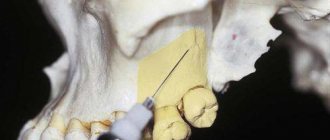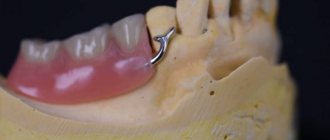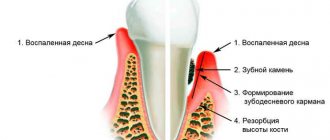Coronal-apical methods for root canal treatment
The achievements of modern dentistry make it possible to treat various diseases of the oral cavity and save teeth that previously would have definitely had to be removed. Complex procedures require not only special expensive equipment and instruments, but also high medical qualifications.
Let's look at the coronal-apical methods for treating the measles canals, which are successfully used in modern dentistry.
Features of the technique
After processing the base of the canal, the dentist evaluates its working length and begins cleaning the internal area
The essence of this method is that the doctor uses special instruments to expand the root canal towards the apical foramen. First of all, the dentist treats the base of the canal, then moves on to the intermediate third, and after that evaluates its working length and begins cleaning the inner area.
This technique is the least traumatic and at the same time quite labor-intensive, since the dentist has to constantly evaluate the length of the canal, selecting instruments by size.
Indications
Dentists usually use this technique in the following cases:
- The tooth cavity is severely affected by infection and there is a high risk of its spreading beyond the root apex
- There is a filling in the dental canal that needs to be removed
- Automated nickel-titanium profiles or GT files are used for work
Advantages and disadvantages of the technique
With a large number of advantages of coronal-apical processing methods, the inability to determine the length of the canal is a significant drawback
Coronal-apical treatment methods have the following advantages:
- Allows you to reach the farthest part of the tubule
- Gradual removal of waste particles reduces the risk of intracanal infection
- It is easy to inject medicine into the resulting depression
- The risk of the tool getting stuck inside the tooth is minimized
- The risk of blocking the far part of the canal with dentin particles and destroyed soft tissues is minimal
- The method allows not to reduce the working depth
- The natural shape of the root canal is not disturbed
The main disadvantage of the technique is that the doctor cannot determine in advance how long the canal is and how clogged it is. Therefore, it takes him quite a lot of time and effort to process the withdrawal.
Step Down Technology
The essence of this technique is to form a cone-shaped working tubule. This shape allows you to conveniently work with apical constriction and efficiently fill gaps.
Processing stages
- Determination of the working length of the tubule. To do this, the patient needs to take an x-ray of the tooth. From this image, the doctor determines how many root canals are in the tooth, how they are located and what their length is.
- Expansion of the mouth. The orifice is expanded using a set of K-files. First, the doctor works with K-files No. 8 and No. 10, depending on the extent of the damage. They pass almost the entire depression, not reaching approximately 0.4 - 0.5 cm to its end or to the place where it bends. To widen the canal, the dentist uses H-files or K-files. First he works with the thinnest tool, gradually changing it to a thicker one. Usually the following files are used: No. 15, then No. 20, No. 25, No. 30 and so on. As processing progresses, the canal increases in diameter, becoming more passable. The expansion does not reach the apical foramen by about 0.5 cm. After manual processing, the doctor proceeds to use a drill and uses Gates Glidden burs to form the orifice. At the same time, he also starts work with a small tool, moving on to a larger one.
- Establishing the working length of the recess. First, the doctor passes the pathfinder or K-reamer along the entire canal, and then sends the patient for a repeat x-ray to see the length and width of the treated cavity in the image.
- Cleaning the apical zone. It is carried out using the Step-back technique. Work begins with a large tool, gradually reaching the smallest one - No. 25. At the bottom, the recess takes on a cone-shaped shape, it has an apical stop in the area of the natural apex
- If the treatment proceeds easily, then it is advisable for the doctor to avoid filing movements. In this case, it is necessary to repeatedly advance the main apical file until the lumen is complete. This will avoid clogging. A smooth transition between the inner and intermediate parts of the tubule will make it passable and facilitate filling and penetration of filling material into all recesses. It is very important to seal the canal tightly, leaving no gaps. Otherwise, an infection may develop in it, and the procedure will have to be repeated.
Titanium-nickel profiles allow you to create a smooth intra-canal surface
This method can effectively clean and expand the root canals. For work, nickel-titanium profiles are used, which help to form a smooth intra-canal surface without notches or sharp transitions. These profiles are durable and chemical resistant.
One of the advantages of the method is that the waste material is immediately removed and does not fall deep into the tubule. This reduces the risk of infection to a minimum.
Crown Down Technology
The essence of this technique is that the doctor treats the depression in the direction from the crown to the gum. Work begins with large tools, gradually moving to small ones. Waste material is removed in parts. The parietal layer of dentin is scraped off with a thin part of the file to avoid its fracture or jamming.
The Crown Down technique is relevant in cases where it is necessary to give the mouth the shape of a funnel.
This is often done on difficult-to-pass streamers, as well as in the treatment of exacerbation of chronic apical periodontitis, when there is a need to prevent the spread of infection beyond the apical foramen. With this method, the natural shape and direction of the tubule is not disturbed, and healthy areas are not affected.
The technique involves the use of the following tools:
- Gates Glidden
- Profile series 04
- K-File
- GT-Rotary
Stages of root canal treatment using Profiles
The Crown-Down technique using Profiles is similar to the previous technique and includes the following steps:
- The dentist locates the canalicular orifice using Pathfinder, K-File
- Then he widens the mouth, working Profile No. 40
- After this, it is necessary to determine the working length of the recess and the initial file, which should be 2 - 3 sizes smaller than the initial profile; it is inserted half the depth of the tubule
- The recess is expanded with a larger profile
- The middle part of the outlet is cleaned with a profile with a diameter smaller than the first for a length of up to three quarters
- The inner area of the tubule is cleaned with an even smaller instrument.
- The last couple of millimeters of the recess are processed manually
Stages of root canal treatment with Gates Glidden
Using Gates-gildden tools of different numbers, almost the entire length of the tooth canal is processed
- The doctor finds the opening of the duct using K-File or Pathfinder
- Enlarges the hole with Gates Glidden tools No. 5 and No. 6
- Moves a couple of millimeters below the mouth with the same tool, but No. 4
- Advances another couple of millimeters using Gates Glidden #3
- Introduces Gates Glidden No. 2 to machine the recess to one-half to two-thirds of its length
- Sends the patient for an x-ray and then checks the working length of the hole on the image
- Manually processes the apical region of the root
The Crown Down technique is quite labor-intensive, so doctors prefer to use machine tools to make the work easier. The dentist's task is to expand the tubule to such a diameter that it can be easily injected with medicine and then sealed.
When expanding the canal, it is important not to overdo it, otherwise the strength of the dental tissues will significantly decrease. An experienced doctor knows how deep the instrument can be inserted, and x-rays help him correctly determine the length of the canal.
Modern methods of dental canal treatment make it possible to preserve a damaged tooth and significantly extend its lifespan.
Source: https://ZubNeBoley.ru/lechenie/karies-i-pulpit/koronalno-apikalnye-metody-dlya-obrabotki-kornevyh-kanalov/
Step-back.
This traditional method of instrumental root canal treatment involves the use of steel files (mainly K-files). Initially, the smallest file is used to determine the working length of the root canal. Then the diameter of the file is determined, which easily reaches the working length, let's assume it will be No. 20. We expand the apical part of the canal to No. 25. After reaching the working length, file No. 25 is followed by file No. 30, which extends 1 mm less than file No. 25. Then file No. 35 goes to a depth 1 mm less than the previous one, etc. from apex to mouth in 1 mm increments. After the required number of “steps,” the canal walls are smoothed (it is advisable to use hedstrom files, excluding rotational movements), and a cone is formed with the narrowest part at the apical foramen, gradually expanding towards the canal mouth.
Despite the high reliability of the retreat technique from the point of view of procedural errors, it is not optimal for the infection control stage of endodontic treatment, since when a file is inserted into the canal, it passes through the infected areas of the pulp chamber and transport of microorganisms to the root apex occurs. Instrumental processing leads to the formation of a fairly large amount of dentinal filings along the entire length of the canal. To avoid blocking the channel and preventing the passage of the next larger file, first of all, it is necessary to remove all sawdust, which is a difficult task due to the small taper. For this reason, when using this technique, the success of treating teeth with infected canals is approximately 15% lower than with uninfected ones. Also, stainless steel files lose flexibility as the diameter increases. Usually this lack of flexibility of large files is the main cause of most complications, such as blocking of the instrument in the canal, the formation of steps, funnels, and perforations. Thus, the retreat technique is not effective enough in the infection control phase of endodontic treatment.
Techniques for Using Endodontic Instrumentation
This article is a continuation of the topic of endodontic instrumentation and methods of its use.
Determination of the working length of the root canal
Determining the working length of the root canal can be considered a key point in endodontic treatment. Being an integral stage, it does not take much time, however, it should not be neglected.
The working length can be defined as the distance between a conventional point on the tooth crown (for example, any preserved cusp), which we remember throughout the treatment, and the physiological apex.
There is a difference between certain types of constrictions in the apical third that must be remembered.
Physiological narrowing is the point of transition between endodont and periodontium; the walls of the canal in this place are made of cement.
Anatomical apex is the anatomical tip of the tooth root.
X-ray apex – image of the anatomical apex on the Rh-gram.
Methods for determining the working length of the canal include the use of an apex locator, X-ray, tactile, tabular, paper pins and the sensitivity method.
Apex locator
It is impossible to imagine modern endodontics without an apex locator. Its action is based on determining the location of the enamel-dentin border.
The hard tissues of the tooth and the mucous membrane have different resistance indicators (higher for hard tissues). When the instrument is inserted into the canal, the resistance on the metal part of the mouthpiece increases sharply.
An open electrical circuit is created. When the constriction is reached, the circuit closes.
Modern apex locators work equally well in dry or wet canals. The method has an accuracy of 90% or more, provided that the canal is not blocked by sawdust from infected dentin.
Tabular method for determining working length
The tabular method for determining the working length is based on the use of the average long-studied lengths of the root canals of each tooth. But no one has canceled the individual parameters of each person.
X-ray method
The radiographic method is suitable for filling the canal up to the radiographic apex. On the plus side, the method is objective; in most cases, it is easy to recognize the top with a correctly taken picture.
The disadvantages are that the structures may overlap each other in the image, there is a high probability of poor visualization of curved canals, difficulties in performing in some patients (increased gag reflex, radiation exposure).
Paper point method
The paper pin method is based on moistening the tip of the pin while bringing it to the top. It can be wetted with blood, serum, pus.
Tactile method
The tactile method is the determination of the working length of the canal based on one’s tactile sensations. The result depends on the doctor’s experience, since the technique is complex and is not effective if the apex is unformed.
The patient's pain can also help in determining the working length at the moment the instrument penetrates the apex and comes into contact with the tissues of the apical periodontium.
After determining the working length, preparation or mechanical treatment of the root canal begins. Today, many methods have been invented, each of them has a specific purpose, and also has advantages and disadvantages. To understand the specifics of creating a root canal shape and subsequent filling, you should start with the basic techniques.
Step back technique (step back)
The Step back technique is considered basic in the study of the art of endodontics. It, being the most popular, is easy to learn and perform.
Stage 1 – passage of the root canal and determination of its working length
Root canal passage is performed using K-reamers. After passing the canal to the apical foramen, the working length is established using a targeted Rh-gram with the instrument inserted into the root canal. The established working length is fixed with a stopper.
Stage 2 – formation of the apical stop
The purpose of this stage is to create an apical stop for the subsequent gutta-percha pin and endosealant to prevent protrusion beyond the apical foramen into the periodontal tissue.
We begin this stage by processing the root canal with a K-file of the same number, which managed to reach the apical foramen and with which we felt it jammed in the apex area. The instrument is inserted into the root canal and processed with sawing movements up and down. After this, the canal is washed with an antiseptic solution.
Next, use the tool of the next number with the same length set by the stopper. Mechanical and medicinal treatment of the canal is repeated. Use tools 3-4 numbers larger than the original (but not less than No. 25 - for adequate preparation and rinsing of the canal). The last tool is called Master file.
After these manipulations, the root canal acquires a conical shape, which corresponds to the taper of the instrumentation and standard gutta-percha pins.
Stage 3 – treatment of the apical third of the root canal
Continue processing the canal with the next instrument number, but reduce the length by 1 mm. The next tool will be 2 mm smaller, then 3 mm smaller, and so on. Between tools we return to the Master file each time to smooth out the steps in the apical third. Do not forget about antiseptic treatment of the channel between all instruments.
Stage 4 – formation of the middle and upper thirds of the root canal
The goal is to create a funnel-shaped canal mouth for subsequent adequate rinsing with an antiseptic and filling.
It is recommended to use Gates Glidden sequentially from number 1 to number 3. We use it in the straight part of the channel. This stage is completed by passing the Master file over the entire length of the channel.
Stage 5 – final alignment of the canal walls
To give the final conical shape to the canal, its walls are passed and smoothed using a Master file.
In addition to the apical-coronal methods, which include the standard technique (canal preparation with K-reamers from smaller to larger sizes) and the “step back” technique, there are coronal-apical methods, including Step Down and Crown Down.
The advantage of coronal-apical methods is to simplify the antiseptic treatment of the canal, facilitate access to the apical third of the canal, prevent jamming of the instrument and the creation of a dentinal plug in the lower third of the canal, prevent the pushing of infected tissues beyond the apex, maintain the anatomical shape of the canal and there is no “loss of working length.” The disadvantage is the difficulty in determining the working length and patency of the root canal.
Step Down technique
Stage 1 – preliminary assessment of working length
The instrument is not inserted to the top. The radiograph determines the number of root canals, their curvature and estimated length.
Stage 2 – expansion of the mouth, formation of the upper and middle third of the canal, creating access to the apical third
A thin K-file (No. 8 or 10) is inserted into the root canal 4-5 mm or until the beginning of the curvature. Processing of this part of the canal begins with K or H-files, thus not reaching the apex. The stage is completed by using Gates Glidden from 1 to 3 numbers, inserting it into the canal only 1-2 mm.
Stage 3 – passing the apical part and determining the length of the root canal
They pass with a K-rimmer until it jams and determine the working length as in the “step back” technique.
Stage 4 – treatment of the apical third with an instrument and formation of the apical stop
The treatment is carried out in the same way as in the Step back technique. The channel takes the shape of a cone.
Stage 5 – final alignment of the walls
The final alignment is carried out with the same instrument used for processing the apical third of the canal.
Crown Down technique
The Crown Down technique is successfully used in case of significant infection of the root canal, to prevent the removal of dentinal filings beyond the apex, for comfortable medicinal treatment of the canal and in the treatment of periodontitis in children.
Stage 1 – insertion of K-file No. 35 to a depth of 16 mm.
If difficulties arise, the causes may be curvature of the root canal or its narrowing. If the cause is curvature, then we process part of the root canal until the curvature occurs. If the reason is narrowing, we take a smaller file and try to go 16 mm. The goal is to freely pass the K-file No. 35 to a length of 16 mm.
Stage 2 – determination of the “temporary” working length
On the Rh-gram we determine the intermediate working length with the instrument in the canal not brought to the apex by 3 mm.
Stage 3 – processing the canal to a “temporary” working length
Stage 4 – determining the final working length
As in stage 2, we use a photograph to determine the working length with the instrument inserted into the root canal.
Stage 5 – root canal expansion
The expansion of the canal is initially carried out with K-file No. 40, then No. 35, etc. until working length is reached. The instrument is inserted into the root canal, without pressure, rotated two turns clockwise and withdrawn. With each subsequent tool they try to move deeper, scrolling it clockwise.
After this, the cycle is repeated again, but starting with file No. 45. The next cycle is from file No. 50. Continue until the apical third is expanded to the desired size, but not less than No. 25.
In the next article we will get acquainted with the options for medical treatment of root canals. Their features, pros and cons of each antiseptic.
The article was written by O. Vishnyak specifically for the OHI-S.COM website. Please, when copying material, do not forget to provide a link to the current page.
Source: https://ohi-s.com/uchebnik-stomatologa/metodiki-ispolzovaniya-endodonticheskogo-instrumentariya/
Crown Down technique (from the crown down)
3Crown Down technique was proposed in 1995. The advantage of the technique is that stronger and larger instruments work in the coronal part of the canal, “paving” the way for smaller (less durable) instruments. In this case, first of all, the bulk of the contents of the root drip is removed, which significantly reduces the likelihood of pushing it past the top. According to the classical method, the upper third of the canal is first treated with machine slowly rotating (200-300 rpm) Gates Glidden burs or large machine K-files. As you approach the apical part of the canal, smaller instrument sizes are used (Fig. 18).
Rice. Fig. 18. Channel profile depending on the taper of tools during sequential processing with profiles.
Crown Down Benefits (Clinical)
§ Ease of removing obstacles to the passage of the root canal to the apex;
§ Improved tactile sensitivity;
§ Better conditions for penetration of irrigation solutions;
§ Direct access to canal curvatures;
§ The instrument deviates less from its direction when passing the curvature of the canal due to reduced contact with the walls of the canal, there are fewer blockades and fragments of instrumentation;
§ Closer to ideal shape of the canals, facilitating obturation;
§ Acceptable time frames
Crown Down Benefits (Biological)
§ Rapid removal of contaminated, infected tissue from the root canal system;
§ Reducing the likelihood of pushing infected tissue beyond the apex;
§ More complete removal of the smear layer due to improved contact of the chelating agent with the canal walls;
§ More precise control over working length, cleaning and expansion of the canal, taking into account the biology of the apical tissues of the root and surrounding tissues
“From the crown down” is effective in the treatment of acute and aggravated apical periodontitis in order to prevent infection of the apical periodontium
Despite the type of instrumentation used and the technique of its application, the instruments touch only 40-60% of the surface of the root canals (B. Johnson, 2003). Therefore, drug treatment of the root canal is of particular importance.
Drug treatment.
As a result of root canal preparation, a smear layer is formed on the surface, which is a substrate for the growth of bacteria and adversely affects the adhesion of the filling material to dentin. In addition, today the existence of additional canals in the cervical, middle and apical thirds of the canal has been proven (Tronstad, 1991), the treatment of which by instrumental means is not possible. Using a combination of different agents, penetration of additional tubules, disinfection and removal of the smear layer can be achieved. Sodium hypochloride and the chelating agent EDTA have proven themselves to be effective medicinal treatments.
§ Sodium hypochloride (formation of hypochlorous acid and release of chlorine when interacting with residues of organic substances). Hypochlorous acid acts by oxidizing the sulfhydryl groups of bacterial protein systems, disrupting the metabolism of the microbial cell. 1-5% solutions are used, the optimal concentration is 3-3.5% (Borovsky, 2005). Repeated application to treat the canal after each endodontic instrument is recommended. The drug is effective when used for a long time - at least 10 minutes, and preferably 15-20 minutes.
§ EDTA – ethylene diamine tetraacetic acid, 15-17% gel, high efficiency in removing inorganic components of the smear layer: interacts with calcium in dentin, forming salts;
§ The combined use of EDTA and sodium hypochloride is the best result when removing the smear layer from the root canal!
For medicinal treatment, a special syringe is used with needles of different sizes that have side holes to allow the infected material to be washed out of the canal (Fig. 19).
Rice. 19. Rinse the root canal with an endodontic syringe.
Requirements for the canal after mechanical and antiseptic treatment:
§ The root canal must maintain its direction;
§ Be expanded to a sufficient number of sizes (at least 30-35 sizes);
§ End with an apical constriction;
§ Do not have protrusions on the walls;
§ Do not contain infected dentin.
Stage 7
Drying the root canals.
This is done using paper pins that match the size of the main pin. The criterion for the readiness of the root canal for filling is the absence of moisture and blood on the paper point (Fig. 20).
rice. 20. Drying the root canal.
3
Simplified anatomical Crown Down technique: demonstration (video) and protocol
This video demonstrates a variant of the crown down root canal treatment technique (from the crown down), called the simplified anatomic technique by the author. The technique was developed by Professor Andre Machado, Brazil; the performer is one of his students.
The technique involves the absence of pressure (pressureless) and is recommended for curved canals. According to the author of the video, one of the advantages of this technique is the successful combination of low cost of its use and high efficiency.
The technique includes five steps.
- Pulp removal (with a “carpet path”).
- Formation of the coronal and middle thirds.
- Snapshot to determine the full working depth of the tool.
- Formation of the apical third of the canal.
- Final irrigation (not shown in this video).
The video shows all 27 steps and is almost 11 minutes long. If desired, you can “skip” a step when its essence becomes clear. Below is the protocol in text, and at the very end of the article is a short English-Russian glossary of terms used in the video. For those who want to improve their “dental English”.
Subscribe to the Stomanet.ru channel!
[yuzo_related]
Pulp removal
- Pulp removal. File No. 15 H, 16 mm, filling motion.
- Irrigation.
- Pulp removal. File No. 10 K 18 mm, reciprocating twisting movements (as when winding a watch), alternating with pulling.
- Irrigation.
- Pulp removal.
File No. 10 K 20 mm, reciprocating twisting movements (as when winding a watch), alternating with pulling. - Irrigation.
- Pulp removal. File No. 08 K 22 mm, reciprocating twisting movements (as when winding a watch), alternating with pulling.
- Irrigation.
- Pulp removal.
File No. 06 K 24 mm, reciprocating twisting movements (as when winding a watch), alternating with pulling. - Irrigation.
- "Carpet". File No. 08 K 24, vertical reciprocating movements (up and down)
- "Carpet".
File No. 10 K 24, reciprocating movements vertically (up and down) - Irrigation.
- "Carpet". File No. 15 FF 24, reciprocating movements vertically (up and down).
Formation of the coronal and middle thirds
- Formation of the coronal and middle thirds. Drill GG (Gates-Glidden) #04, 12 mm.
- Irrigation. Passing with 10 K file.
- Formation of the coronal and middle thirds. Drill GG (Gates-Glidden) #03, 15 mm.
- Irrigation.
Passing the file 10 K, movements - as when removing pulp. - Formation of the coronal and middle thirds. Drill GG (Gates-Glidden) #02, 18 mm.
- Irrigation. Passing the file 10 K, movements - as when removing pulp.
Formation of the apical third of the canal
- Irrigation.
- Formation of the apical third of the canal. File No. 35 FF, 20 mm, reciprocating twisting movements (as when winding a watch), alternating with pulling.
- Irrigation. Passing the file 10 K, movements - as when removing pulp.
- Formation of the apical third of the canal.
File No. 30 FF, 22 mm, reciprocating twisting movements (as when winding a watch), alternating with pulling. - Irrigation. Passing the file 10 K, movements - as when removing pulp.
- Formation of the apical third of the canal.
File No. 25 FF, 24 mm (passing), reciprocating twisting movements (as when winding a watch), alternating with pulling. - Irrigation. Passing the file 10 K, movements - as when removing pulp.
Show your patients how their teeth work.
This will help them understand you better and appreciate the treatment you provide more. The posters “Anatomy of a tooth blueprint”, “Anatomy of a tooth light” and “How a tooth works” will help you in this matter:
Stylish, light and bright. Choose:
https://laa.stomanet.ru/product/stomatologicheskie-plakaty-anatomiya-zuba-blyuprint-a2/
https://laa.stomanet.ru/product/stomatologicheskie-plakaty-anatomiya-zuba-lajt-a2/
https://laa.stomanet.ru/product/stomatologicheskij-plakat-kak-ustroen-zub-a2/
Learning Dental English
Coronal third, middle third, apical third
– coronal third, middle third, apical third (tooth root).
Glide path
– “carpet path”, a processed section of the canal that makes it easier.
Working length
– working length (for example, endotool).
Mesiobuccal
– medial buccal (about the root); mesial - medial, buccal - buccal.
GG drill
– Gates-Glidden drill
Patency
– channel passage
Source: https://stomanet.ru/terapevticheskaya-stomatologiya/endodontiya/uproshhyonnaya-anatomicheskaya-tehnika-crown-down-demonstratsiya-video-i-protokol/
Coronal-apical methods
February 18, 2014
Coronal-apical methods involve the preparation and expansion of the root canal from the orifice to the apical foramen, using instruments from larger to smaller sizes.
When using these methods, the ostial and middle third of the root canal are first prepared. Then the working length is determined. Only after this the apical part of the canal is processed and an apical stop is created.
Coronal-apical methods are indicated:
firstly, when the contents of the root canal are significantly infected, when there is a risk of pushing pulp decay beyond the apex;
secondly, when using machine methods of channel expansion, for example, when the direct channel is expanded by Pesso-reamers;
thirdly, when working with machine nickel-titanium profiles or GT files.
Advantages of coronal-apical methods:
- Good access to the apical part of the canal is provided.
- The risk of infection of periapical tissues is reduced due to the gradual removal of decay from the canal.
- It makes it easier to carry out medicinal treatment of the canals.
- The risk of instrument jamming in the apical part of the canal is reduced.
- The risk of blocking the apical part of the canal by soft tissues and dentinal filings is reduced.
- The risk of “loss of working length” is reduced.
- The anatomical shape of the canal is preserved.
The disadvantage is that at the beginning of work it is impossible to accurately determine the patency and working length of the canal, which creates a certain psychological discomfort for the dentist.
"Step Down" technique
This technique, like “Step-back,” involves giving the canal a cone-shaped shape during mechanical processing to create favorable conditions for filling.
Mechanical treatment of the canal in accordance with the “Step Down” technique is carried out as follows.
The first stage is a preliminary assessment of the working length of the root canal.
With this technology, the tool is not inserted to the apex at the beginning of processing. First, a diagnostic radiograph is taken without instruments in the canal. The number of root canals, the degree of their curvature are assessed, and the approximate length is determined.
The second stage is the expansion of the mouth, the formation of the mouth and middle parts of the root canal, and the creation of access to the apical third of the canal.
This stage begins with the introduction of a thin K-file (No. 08 or No. 10 according to ISO) into the canal, not reaching the apical foramen by 4-5 mm or before the canal begins to bend.
Then the passed part of the canal is expanded with hand tools - H-files or K-files - starting with a smaller size and gradually moving to larger ones: No. 15 => No. 20 => No. 25 => No. 30, etc. Thus, gradually increasing the diameter of the file, the canal is processed, not reaching the apical foramen by about 5 mm. The patency of the root canal is constantly monitored with thin instruments.
Finally, Gates Glidden burs are used to form the mouth of the canal. In this case, processing is carried out starting with a smaller tool and gradually moving to a larger one. In this case, “Gates Glidden” No. 3 is recommended to be inserted into the mouth of the canal by only 1-2 mm.
The third stage is passing the apical part of the canal and determining the working length.
At this stage, the apical part of the canal is passed to the apex with a thin K-reamer or pathfinder. A “measuring” radiograph is taken and the working length is determined.
The fourth stage is instrumental processing of the apical part of the root canal, formation of the apical stop.
At this stage, the apical part of the canal is treated using the “Step-back” technique. The expansion of the channel is carried out no less than up to ISO No. 25. In this case, the apical part of the canal is given a cone-shaped shape with an apical stop in the area of the physiological apex.
At this stage, the canal walls are aligned along the entire length with a Hödström file, the size corresponding to the file that was used to form the apical part.
“Crown Down” technique (from the crown down)
The “Crown Down” technique involves staged processing of the canal from the mouth to the apex with a sequential change of instruments from larger to smaller sizes. In this case, parietal dentin is removed only by the apical part of the instrument, which improves tactile control and reduces the risk of jamming and fracture of the instrument.
Mechanical treatment of the canal in accordance with the “Crown Down” technique is carried out as follows.
The first stage is the introduction of a K-file No. 35 into the root canal to a depth of 16 mm.
First, they try to insert a K-file No. 35 according to ISO to a depth of 16 mm into the root canal. If it is not possible to insert this file to such a depth, an x-ray of the tooth is taken with the instrument inserted into the canal. The purpose of this operation is to find out what caused the instrument to get stuck: curvature of the root canal or narrowing of its lumen.
If the reason is a narrowing of the root canal, then it is expanded with thinner K-files to a depth of 16 mm until a K-file No. 35 is inserted at 16 mm.
If the reason for the stuck K-file No. 35 is curvature of the root canal, then the canal is processed to the area of curvature.
If the K-file was immediately inserted into the canal 16 mm or more, mechanical treatment of this part of the canal is performed.
The second stage is the determination of the “temporary working length”.
For this purpose, a “measuring” radiograph is taken with a K-file in the canal, which is approximately 3 mm short of the physiological apex. The length of the channel is calculated. The indicator assigned when analyzing such a radiograph is called the “temporary working length”.
To determine the “temporary working length,” a diagnostic radiograph can also be used if it was taken at the first stage of instrumentation of the canal.
The third stage is the passage of the apical part of the canal to the “temporary working length”.
Next, take a K-file No. 30, insert it into the canal all the way and rotate it clockwise without pressure until maximum movement in the apical direction and remove it from the canal. Then a similar operation is carried out using K-file No. 25, then No. 20, etc.
until the “temporary working length” is reached (for example, up to No. 25).
The fourth stage is the determination of the “final working length”.
A “measuring” radiograph is taken with the endodontic instrument inserted into the canal to a “temporary working length”. The “final working length” is determined.
The fifth stage is expansion of the root canal.
https://www.youtube.com/watch?v=qiwBFr16bVk
This stage begins by inserting a K-file No. 40 into the canal until it stops, then without apical pressure, make two full turns clockwise and remove the file from the canal.
Next, take a K-file No. 35, insert it into the canal as far as it will go and rotate it clockwise without pressure until the instrument moves maximum in the apical direction and remove it from the canal.
Then a similar operation is carried out with K-file No. 30, then No. 25, No. 20, No. 15, etc. until the working length is reached (for example, up to No. 30).
After this, the same manipulations are repeated, starting with K-file No. 45, then with No. 50. Each time they strive for deeper penetration of files.
Mechanical treatment of the canal is continued until its apical part is expanded to the desired diameter, but not less than to No. 25 (for example, to No. 40).
Using the “Crown Down” technique allows you to maintain the original shape and direction of the channel, however, this method is quite labor-intensive. Therefore, it is most often used when expanding root canals using machine tools: profiles or GT files.
The canal must be widened enough to carry out full medicinal treatment and reliably seal it. On the other hand, excessive expansion of the canal can lead to lateral perforation, weakening of mechanical strength and root fracture.
The main criterion for the sufficiency of mechanical treatment of the root canal should be the appearance of white dentinal filings.
Source: https://stom-portal.ru/terapiya/pulpit/metodika-instrumentalnoj-obrabotki-kornevykh-kanalov/koronalno-apikalnye-metody.html
Crown Down method using Ni-Ti TEE Poldent file systems
These instruments are made from a durable and flexible nickel-titanium alloy, allowing the instrument to treat root canals at a 90º angle without causing accidental perforation of the root walls.
1. ►Treat the tooth.
2. ►Define all channels.
Clean all channels with a K-file, size 15 to a depth of 2-3 mm before reaching the top.
3. ►Treatment of the root area.
Design cavity outlet NiTi TEE taper 21 size 30 (black/blue). Continue with a size 30 taper 8 file (blue/blue) to 1/3 - 1/2 the depth of the canal. Do not insert files into the canal bend. Remove any remaining bone tissue from the canal and file, and rinse the canal thoroughly.
4. ►Determine the working depth of the channel.
5. ►Treatment of the entire working length of the canal.
Monitor changes in canal depth using a size 15 hand K-file and rinse the canal as each size of NiTi TEE file is used.
♦ Start processing with NiTi TEE taper 6 file size 30 (red/blue). Then go a few millimeters deeper into the canal with a taper 4 file, size 30 (yellow/blue).
♦ Continue processing in the channel with a 4/25 (yellow/red) or 2/20 (white/yellow) file. In most cases, at this stage the top of the channel has already been reached. If the working length has not yet been reached, the procedure is repeated.
Fig.29. Root canal treatment technique using the “Crown Down” method using “NiTi TEE”
6. ►Vertex processing.
Vertex processing begins with the smallest file size, gradually increasing the size of the applied files. Starting processing with the file that was last used and increasing the file sizes one by one (for example: NiTi TEE 2/20, 4/20 to 4/25 (yellow/red). The last tool to be used is the NiTi TEE 4 file /30. All tools must be brought to the top of the canal and, as a result, its processing is completed. If it is necessary to process more of the top, then work continues with tools with a taper of more than 2 or tools for manual processing of large sizes (45, 50, etc. .d.).
7. ►Final processing.
The final treatment of the canal should be done with NiTi TEE 12/30 (black/blue) and 8/30 (blue/blue) files to smooth the canal walls and create a tapering taper. The canal must be processed to a depth of 2/3 of the canal bend.
Fig.30. Mechanical treatment of the root canal with special instruments made of nickel-titanium alloy.
The advantage of this method is that at each moment of time a small part of the canal wall is processed and, accordingly, the tool experiences less load (compared to the step-back technique).
Depending on the channel width, the following FlexMaster tool sequences are recommended:
wide channels:
crown-down technique to apex: 06/40, 06/35; 06/30; 06/25; 06/20; 04/20
middle channels:
crown-down technique: 06/30; 06/25; 06/20; 04/30; 04/25 with final apical preparation: 02/20; 02/25; 02/30
narrow channels:
crown-down technique: 06/25; 06/20; 04/30; 04/25; 04/20 with final apical preparation: 02/20; 02/25; 02/30
In the case of a medium or narrow canal, after the crown-down phase, the canal is processed with files of increasing size according to ISO with length control using the apical preparation technique.
DOUBLE FLARED METHOD
This method was developed according to the requirements of the coronal-apical method. The Double flared method involves gradually preparing the root canal with instruments of gradually smaller sizes. The following steps should be followed:
I. Inserting a rinsing solution and a thin intracanal instrument into the root canal with light pressure and pulling movements to the expected length. In this case, they try to introduce the rinsing solution to the full working length of the root.
II. Measuring X-ray and final determination of the working root length.
III. Irrigation and insertion of a small intracanal instrument to a length of approximately 14 mm or until the canal begins to bend. This instrument must be freely located in the root canal.
IV. Flushing the canal and inserting a smaller instrument 1 mm deeper. In this case, preparation of the root canal bend is not carried out. Reciprocating movements are used to prevent clamping of the instrument in the root canal.
V. Repeat the previous step using the next tool size.
VI. Repeat the previous step until the working root length is reached. Necessary adjustments to the working root length can be made using additional x-rays.
The root canal can be finally prepared using the step back method to the desired length. This method is indicated for the preparation of straight root canals and the straight portion of curved canals. The use of the method is contraindicated in the presence of complex root canals, teeth with wide canals and a wide open apical foramen. The main advantage of this method is cleaning the root canal and preventing the removal of the contents from pushing into the periapical tissues; can be used in other cases.
"CANAL MASTER" METHOD
With this preparation method, modernized endodontic instruments are used.
The goal of this method is to maintain the original location of the root canal curvature. Using instruments specially designed for this method, thanks to their apical part, dentin can be removed in a targeted manner using rotational movements. Such tools are suitable for both mechanical and manual use. The apical portion of these instruments measures 0.75 mm and consists of a non-cutting tip.
The following steps should be followed:
I. Determination of working length.
II. Preparation with machine instruments before the root canal begins to bend.
III. Using the Canal Master tool, as in the “step back” method, when preparing a curved part of the canal.
This system provides tools of intermediate sizes. This makes conical root canal preparation easier than with traditional instruments.
Previous7Next










